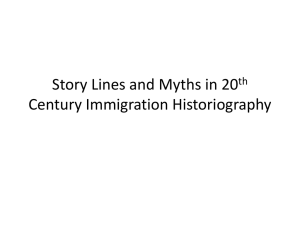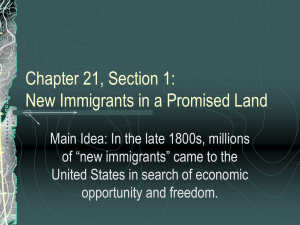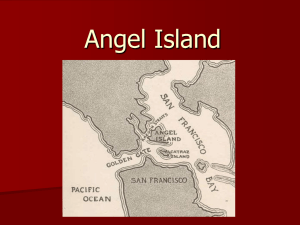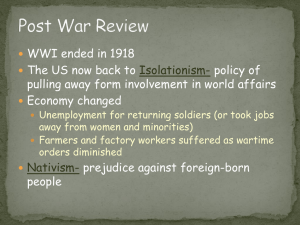Immigration and Urbanization (1865
advertisement
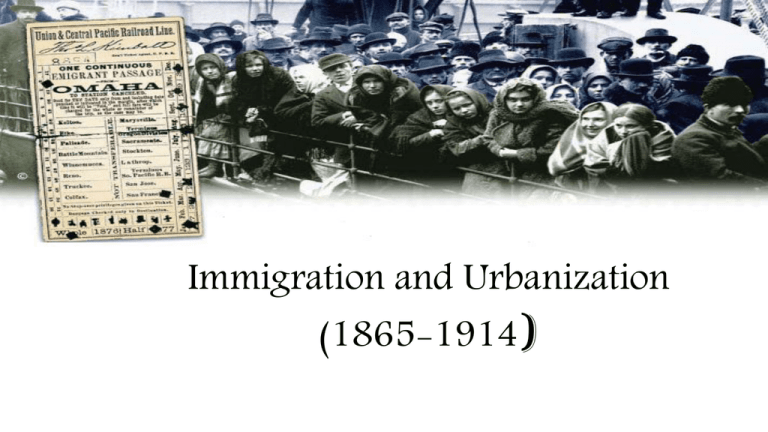
Immigration and Urbanization (1865-1914) The New Immigrants •Poor Catholic or Jewish immigrants often moved to urban areas •1870’s and 1880’s consisted of Northern/Western immigrants. Examples included: Irish, Scottish and Germans •1890’s and early 1900’s included Immigrants from Italy, Hungary and Greece Statistics Between 1870 to 1920 about 20 million Europeans arrived in the United States Many came to escape religious persecution Other Europeans left because of the rising population Between 1800 and 1900 the population of Europe doubled to nearly 400 million This resulted in land scarcity, competition for labor, etc. Ways the New Immigrants were different • • • • 2006 Skin color Customs Religion Language – Very different from English, German, French 4 The Push and Pull Factors • Push – Immigrants fled from religious persecution, wars, political revolt, and land reform • Pull – Plentiful land and employment, recruited for work – “Chain immigrants” joining family or friends who have already settled in America The Immigrant Experience • long voyage – steamships were safer and faster to cross the Atlantic – most traveled in steerage – arrival – New York Harbor: Ellis Island – San Francisco Bay: Angel Island Ellis Island Located in New York Harbor Once the main entry facility for immigrants entering the U.S. Operated from January 1892 to November 1954 12 million immigrants were inspected by 1954 Before Ellis Island 8 million immigrants had been processed at Castle Garden 1907 was the peak year for immigration with 1,004,756 immigrants processed April 17 saw 11,747 immigrants Ellis Island Those with health problems or diseases were sent home About 2% were denied admission to Reasons such as disease, criminal background, or insanity Immigrants who were approved spent from 3 to 5 hours at Ellis Island Ellis Island was sometimes known as "The Island of Tears" Mass processing of immigrants at Ellis Island ended in 1924 after the Immigration Act of 1924 • Vito Andolini arrives at Ellis Island Angel Island An island in San Francisco Bay Provided the same service for those crossing the Pacific as did Ellis Island in the East 1 million people were processed through Angel island Chinese Exclusion Act of 1882 provided tough entry restrictions Immigrants waited on the island for as long as two years as they attempted to get in In 1906 a fire destroyed the facility All processing took place in San Francisco Angel Island • Tour Immigrants Assimilate into• Society “melting pot” • some city populations had more than 40% foreign born • most new immigrants stayed in cities, close to industrial jobs in factories – ghettoes • Americanization programs – faced hostility and competition among natives Overcrowded and Poor Housing • • • • housing conditions deteriorated Immigrants lived in tenements crime poor sanitation – Cholera – Germ Theory Technological Cities • Mass transit – Electric trolley and subway • Elevators • Skyscrapers • Central heating - Trolleys and subways were developed in order to make transportation more efficient. A train of Brooklyn Union elevated cars circa 1907 belonging to the New York Transit Museum collection. The New American Culture Once admitted immigrants faced many challenges: Finding a place to live Getting a job Adapting to a new culture Understanding a new language Many immigrants sought out people that were of similar backgrounds, culture, and language They formed their own communities throughout the nation Created social clubs, churches, and synagogues as a means of bonding together in a new land Cultural Changes • conspicuous consumerism – sale methods change – department stores – brand names • mass culture • education increased – training for urban careers • new forms of entertainment Educate • Schools assimilate immigrants faster than anything else • Upsets some of the older immigrants because the kids want to learn American culture and not their own GROWING CONSUMERISM • The turn of the century witnessed the beginnings of the shopping center, department and chain stores, and the birth of modern advertising CATALOGS AND RFD • Montgomery Ward and Sears were two pioneers in catalog sales • By 1910, 10 million Americans shopped by mail • In 1896 the Post Office introduced a rural free delivery (RFD) system that brought packages directly to every home • sears ad.pdf DAWN OF A MASS CULTURE • Many middle class Americans fought off city congestion and dull industrial work by enjoying amusement parks, bicycling, tennis and spectator sports • American leisure was developing into a multimillion dollar industry THE DEPARTMENT STORE • Marshall Field of Chicago brought the first department store to America • Field’s motto was “Give the lady what she wants” • Field also pioneered the “bargain basement” concept Marshall Fields has been around for almost 150 years Shopping, Sports and Entertainment - Macy’s opens a nine-story building in New York City. Macy’s, New York City, 1902 CHAIN STORES • In the 1870s, F.W. Woolworth found that if he offered an item at a low price, “the consumer would purchase it on the spur of the moment” • By 1911, the Woolworth chain had 596 stores and sold $1,000,000 per week - Baseball, football and basketball gain in popularity. The Cuban Giants began life in 1885 as a team that entertained guests at the Argyle Hotel in the resort town of Babylon, Long Island. - Vaudeville shows became extremely popular. Examples: comedians, song and dance routines, and acrobats Vaudeville - Music such as ragtime became extremely popular as well. Example: Scott Joplin – an African American composer

